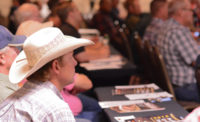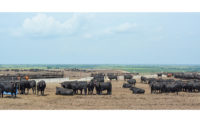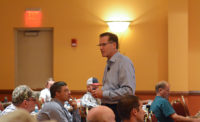Feeding Quality Forum attendees were probably not surprised to hear Dan Basse, Ag Resource Co., say that pricing inputs would be their top challenge in the last quarter of 2012. But the fact that those costs could normalize in the latter part of next year surely piqued their interest.
The market analyst addressed feeders, allied industry and educators at the seventh annual meetings held in Grand Island, Neb., and Amarillo, Texas, in August.
“There aren’t too many years in my career that I’ve talked about surety of supply,” Basse said. “I want all of you to not only think of the cost of feed, but making sure you that you have it.”
He expects the U.S. corn crop to drop substantially from USDA’s estimates, which have not reflected any reduction in harvested acres. Ag Resource puts the average corn yield at the lower range of industry estimates, but their numbers are based on actual field research. If the average falls to 113 bushels per acre, it would move corn prices to above $11 per bushel.
That average is around 28% to 30% below trend, Basse said, also noting that ending stocks will be tight.
“I can’t show deficit stocks,” he said. “Someone has to go without. What is that last residual bushel of corn worth? I don’t know. I don’t know how high is high.”
Corn stocks will likely settle around 650 million to 700 million bushels. They’ve only been that low about 3% of the time since 1973. “Historically, this is unprecedented,” Basse said. That doesn’t necessarily mean the beef business will have to deal with back-to-back record corn-price years.
Regardless of the status of the renewable fuels mandate, Basse says the “ethanol monster” is not the factor it has been the past five years.
“He’s not dead, but he is at least in hibernation. Ethanol has reached its zenith,” Basse said. More efficient cars and driving fewer miles, along with the lower ethanol exports, make that a reality.
“This will be the first year since 2005 in which the world per-capita grain use will decline,” he said. “That’s why this year was looking promising until Mother Nature dealt us this big blow in terms of heat and dryness.”
Digging into historical data, there have never been two consecutive years of widespread drought in the central U.S.
“Even in the 1930s, we had drought in 1934 and 1936, but in 1935 we had average rainfall,” Basse said. “So if I’m in the cattle feeding business, I’m very hopeful that next year’s weather will be normal.”
If famers ratchet up corn acres to 98.5 million and get an average yield of 160 bushels per acre next year, it would put corn in the $4.50 to $5.00 per-bushel range.
“Won’t that be nice?” he asked. “But that’s three or four quarters away.”
To add to the immediate stress, hay production is forecast at 120 million metric tons — the lowest level since 1976. The poor corn crop may provide one saving grace: “The only good news for you is that this is really bad-quality corn. There might be some nice discounts offered relative to poor quality.”
Low test weights and aflatoxin issues are some of the widespread concerns. Herd liquidation is another factor, as feeders look to source calves, but Basse says crop insurance might help. Some Midwestern farmers are looking to chop poor-quality corn and invest their payout in cows.
“What does that mean for the cowherd in the United States? I’m not quite certain, but I do believe it will allow it [to] be more withstanding than I’ve seen in other drought years,” he said. As the domestic population ages, beef demand is down slightly, but the worldwide trend contradicts that.
“When I look at consumption, it is still moving up, so the story of being a livestock producer is still relatively bullish longer term,” Basse said. “We’re also finding from our overseas customers that importing beef is less costly than importing the grain itself.”
That bodes well for trade.
Individual balance sheets are based not only on costs and inputs, but on getting the highest possible revenue. Supporting a branded program is one option: “That’s good for the farmer, and everybody up and down the chain gets the most value,” Basse said. “It helps everyone, including the consumer because he knows he’s getting a high-quality product, so I’m big on branding, going forward.”
Another thing he’s big on? Foresight.
“I want every cattleman to think forward, at least for three quarters, and then we can plan for the good times which will probably happen nine months from now.”
The forum was co-sponsored by Purina Land O’ Lakes, Certified Angus Beef LLC (CAB), Feedlot Magazine and Pfizer Animal Health.




Report Abusive Comment